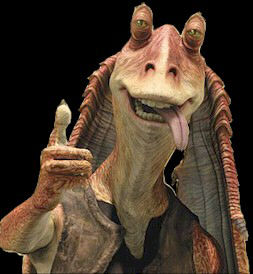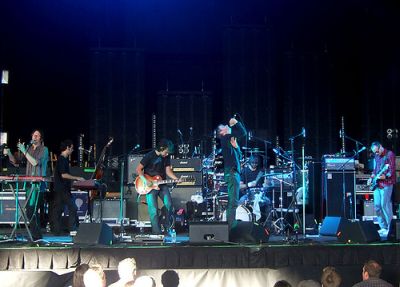
Whoops! I got my franchise turds mixed up for a second. But
The Phantom Menace is pretty much where we have to start the discussion.
Kingdom of the Crystal Skulls is a truly remarkable cinematic achievement: an Indy sequel worse than
Temple of Doom.
It's not worse because of the ludicrous central conceit of the story, as I first thought. I will not detail the ways in which the crystal skull notion is silly, because a) it's actually not that bad an idea, in and of itself, and b) this is the franchise that gave us God, popping out of the Ark of the Covenant like a jack-in-the-box, in order to
melt Nazi faces... can we really split hairs here? As such, I'm not going to fixate on the silliness... in and of itself, anyway.
The problem is more the usage of that silliness. Yes, God himself rained down his fury at the ends of both
Raiders and
Last Crusade. But in each case, the melting of the face was the climax of a story that was otherwise 100% grounded in reality-based adventure. The leaps of logic were in the stuntwork, which was so kinetic and exciting that we ate it up.
But in
Kingdom of the Crystal Skull, as in
Temple of Doom before it, the implausibilities lie in the journey, not the destination. Their stories are propelled forward based solely on preposterous details. The suspension of disbelief is central, rather than collateral.
In
Temple of Doom, for example, we are asked to believe and accept, amongst other things:
* that the human body can live without a heart
* that Indiana Jones is subject to mind control
* and voodoo dolls, too
* that Indiana Jones would drag a loud-mouthed blonde bitch along with him on a life-threatening adventure
Kate Capshaw hatred aside, there's only so much horseshit we can be asked to accept in one bite. It's as if the artisan-style heart removal's WTF-ness is meant to distract us, so that the filmmakers can shove in a bunch of ridiculous details while we're still reeling. If it were the only campy moment, perhaps it wouldn't have been such a crime. But by that point in the movie, we in the audience have seen about 50-60 minutes of pure camp. We're not exactly eager to accept more idiocy. The heart-ripping scene and its hypnosis-dependent aftermath thus stand more as opportunities to roll one's eyes and jump out of the mine cart.
[SPOILER WARNING; SKIP AHEAD]Likewise,
Kingdom of the Crystal Skull's progression is dependent upon accepting the skull's magical function, and its effect on both Indy and Harold Oxley. Which I don't, because the rules are not established with even the most remote believability. When rules get invented in order to move things along (Indy resists Irina's psychic powers, but not the skull's, and oh by the way he doesn't go crazy-go-nuts like Oxley) the natives get restless.
Further, each such
deus ex machina intervention means that we sidestep proactive behavior from the protagonists. For example, how do Indy and friends escape the Soviets' clutches? Why, vine-swinging CGI monkeys and flesh-eating killer ants, of course! And did I mention that the crystal skull's presence creates a FUCKING FORCE FIELD around Indy and Oxley? Compare this to Indy slamming a bad guy's face into an airplane propeller. One is Indy's doing, another is Indy floating along like the rest of us.
And why do the Soviets need Indy? Because the skull turned Oxley into a babbling moron. Oh, I see. So Indy has to look into it himself, in order to communicate with Oxley... but not
too much. Because it's
too much skull-staring that makes you babble. Isn't this all so convenient. Never mind that the primary tool the Russians are using to discover the skull is... ANOTHER SKULL!
COME ON!!![OK, NO MORE BIGGIES]Now, this isn't the first time Indy has been involved in something silly. But much as I loathe
Temple of Doom, even that film eventually finds its legs and keeps us on board. Stupid? Absolutely, but Indiana Jones comes out of the experience relatively unscathed as a character. And as I began, all of these movies are outlandish and ridiculous in some core way.
What makes
KotCS so different is that Indy's not himself. He's just along for the ride.
The appeal of the series isn't simply in paying homage to 30's serials and (now) 50's B-movies, but in the
elevation of that material through one of the most charismatic heroes in film history. The sag of
KotCS comes directly from the sag in Indy's step.
I can't say it any better than
this guy, whose exhaustive and uniformly spot-on list I discovered well after I started working on this. (Sigh.) But I'll sum it up:
* Indiana Jones doesn't care about the Crystal Skulls, so neither do we.
* Every twist is foreseeable and telegraphed, which undercuts every opportunity for tension.
* Those two absences keep our attention focused on the ridiculousness, which we reject because
there's no reason not to.
Simple as that. Not even
Sean Connery could save a movie with such a disastrous skeletal structure.
One
interesting point I've seen made to contradict the utter ridiculousness of
KotCS is that Indy isn't really after the Crystal Skull... his object of desire is Marion Ravenwood. The idea being that Indy has matured, has come face to face with death and mortality, and realizes that Marion, and a family, are how he digs himself out of his old rut and reclaims his Indy groove.
Not a bad notion... but if it's in there, it's the only well-kept secret in the whole goddamn movie. but I don't feel that was established. Nothing Indy does is firmly rooted in a desire to protect Marion. He doesn't even know who the hell he's protecting until he gets to Peru! And everything else is so half-assed that they could not possibly have
effectively established that as Indy's true quest.
Anyway, all ranting aside, it may be a well-made good time, but so is any old amusement park ride. There's a high standard to meet in this series, and this one falls well short of the mark.
Two horribly animated jungle creatures out of five.
(Maybe I should be grateful that the prairie dogs didn't talk. Naaaaaaaah.)




